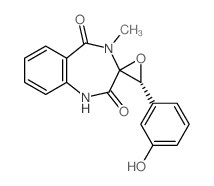(-)-Cyclopenol

(-)-Cyclopenol structure
|
Common Name | (-)-Cyclopenol | ||
|---|---|---|---|---|
| CAS Number | 20007-85-6 | Molecular Weight | 310.30400 | |
| Density | 1.5g/cm3 | Boiling Point | 633.2ºC at 760 mmHg | |
| Molecular Formula | C17H14N2O4 | Melting Point | N/A | |
| MSDS | Chinese USA | Flash Point | 336.7ºC | |
| Symbol |


GHS07, GHS09 |
Signal Word | Warning | |
|
Penicillium discolor, a new species from cheese, nuts and vegetables.
Antonie van Leeuwenhoek 72(2) , 119-26, (1997) The new species Penicillium discolor, frequently isolated from nuts, vegetables and cheese is described. It is characterised by rough, dark green conidia, synnemateous growth on malt agar and the production of the secondary metabolites chaetoglobosins A, B an... |
|
|
Nuclear inheritance of the biosynthesis of cyclopenin and cyclopenol in Penicillium cyclopium.
Z. Allg. Mikrobiol. 24(9) , 615-8, (1984) Balanced heterokarions were grown from Penicillium cyclopium aux-glu 1, a glutamic acid auxotroph producing benzodiazepine alkaloids of the cyclopenin-cyclopenol group, and P. viridicatum aux-met 1, a methionine auxotroph forming these alkaloids in traces onl... |
|
|
Uric acid is a genuine metabolite of Penicillium cyclopium and stimulates the expression of alkaloid biosynthesis in this fungus.
Appl. Environ. Microbiol. 68(4) , 1524-33, (2002) On searching for endogenous, low-molecular-weight effectors of benzodiazepine alkaloid biosynthesis in Penicillium cyclopium uric acid was isolated from ethanolic or autoclaved mycelial extracts of this fungus. The isolation was based on a three-step high-pre... |
|
|
Cyclopeptine synthetase activity in surface cultures of Penicillium cyclopium.
J. Basic Microbiol. 25(6) , 387-91, (1985) Cyclopeptine synthetase, the key enzyme of benzodiazepine alkaloid biosynthesis in Penicillium cyclopium forms cyclo-(anthranoyl-phenylalanyl) from anthranilic acid, L-phenylalanine, the methyl group of L-methionine and ATP. The following in vitro measurable ... |
|
|
PTP1B inhibitory secondary metabolites from marine-derived fungal strains Penicillium spp. and Eurotium sp.
J. Microbiol. Biotechnol. 23(9) , 1206-11, (2013) The selective inhibition of PTP1B has been widely recognized as a potential drug target for the treatment of type 2 diabetes and obesity. In the course of screening for PTP1B inhibitory fungal metabolites, the organic extracts of several fungal species isolat... |